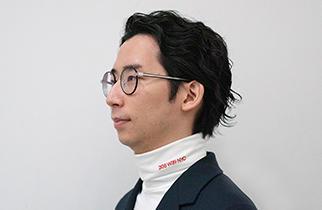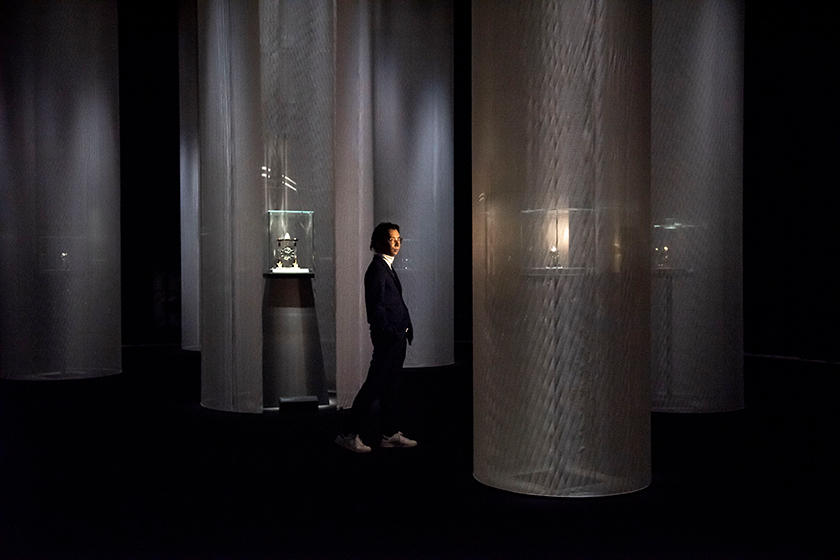
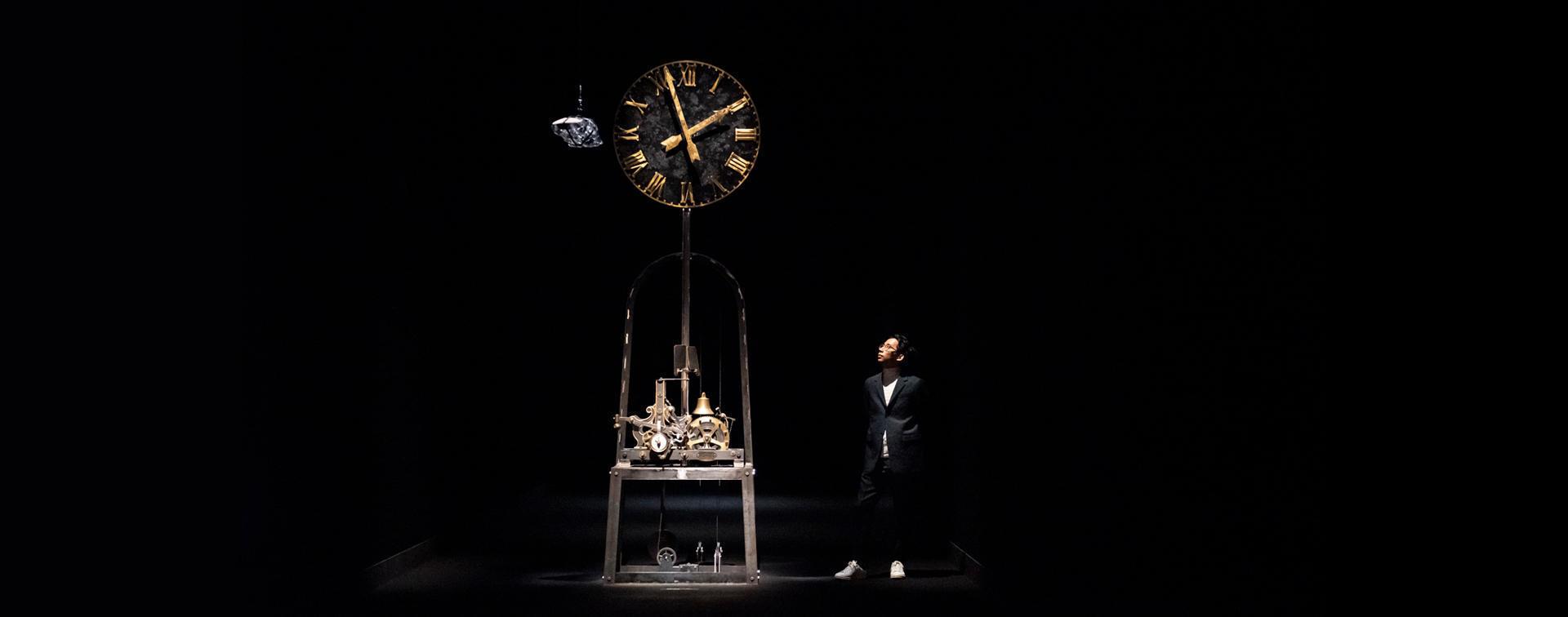
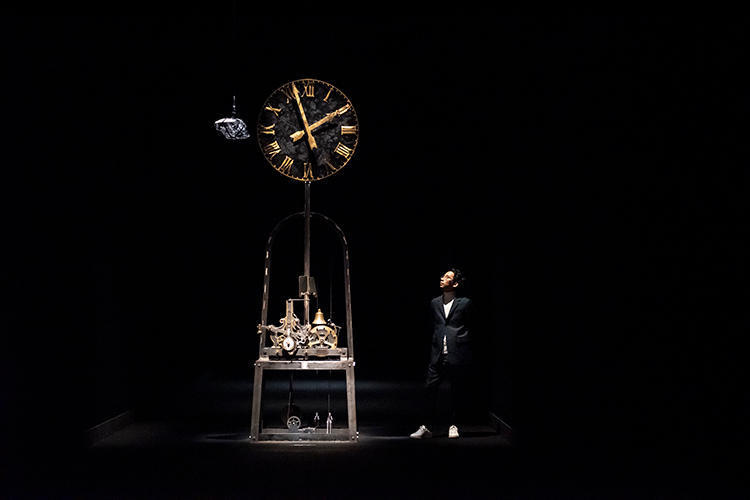
INTERVIEW
110
Eugene KangawaArtist(THE EUGENE Studio)
Identifying the flaws created in the complex society and applying little steps to mend them
Envisioning the society right in front of us, not in the far future
Eugene Kangawa is the founder of THE EUGENE Studio, a contemporary art studio whose scope of work has crossed over to the AI, urban design, education, biotechnology, and more. His non-caption system, an innovative art description system, is employed at “Cartier, Crystallization of Time,” currently exhibited at The National Art Center, Tokyo. We interviewed this young contemporary art artist to get insight on his expectations on this new system, which he developed based on the optimal relationships between the artwork and the audience he observed at his previous exhibitions, along with his opinions on the promising future of arts.
A painting of minimal construction
Our role in "Cartier, Crystallization of Time" is furnishing the non-caption system. To help understand the system, allow me to begin with my previous work, "Series of White Painting" and "Phantosia."
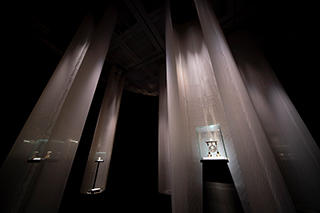
Cartier, Crystallization of Time
This exhibition differentiates itself from the previous exhibitions, which concentrated on the historical pieces, and rather highlights the post-1970's contemporary design works from the Cartier Collection. The creations' innovativeness, modernity, and originality are advocated for the first time through the House's prestigious history. Hiroshi Sugimoto and Tomoyuki Sakakida of the New Material Research Laboratory (N.M.R.L.) design the exhibition space, and THE EUGENE Studio offers the narrative communication at the exhibition. "Cartier, Crystallization of Time" runs until December 16 (Mon.) at The National Art Center, Tokyo.
Photo: Prologue "Space of Time"
The New Material Research Laboratory
© N.M.R.L./ Hiroshi Sugimoto + Tomoyuki Sakakida
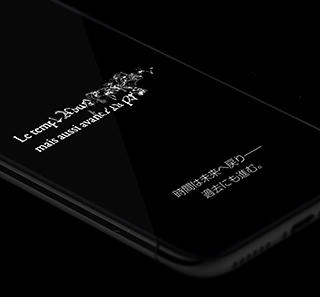
Non-Caption System
This innovative audio guidance system by THE EUGENE Studio employed at "Cartier, Crystallization of Time" is superior to the conventional system. Comprehensive information, including the title, production year, materials, and ownership of each piece, can be accessed in four languages using the guidance system, and it is available for rental at no cost to the visitors. The system automatically detects the location of the artwork for accurate information and helps maximize the exhibition experience providing texts, images, audio and movies.
"Series of White Painting" initially appears to be blank white canvases; however, these canvases traveled to different international cities to be kissed by random people. I consider this series a work of minimal construction. An art critic for a U.S. art theory journal, October, described the series as "(the series) transform the canvases into nomadic shrines to love and memory." In modern days, paintings are not a practical part of our ordinary life and are generally found in art museums and galleries. Back in a day, on the contrary, paintings had a major presence in people's lives and had intimate connections with people in both physical and spiritual terms. Paintings with religious icons like Jesus Christ and Virgin Mary exemplify that statement as people went to bed with those paintings. "White Painting" is similar to those icons in the sense of the structure, behavior and meaning.
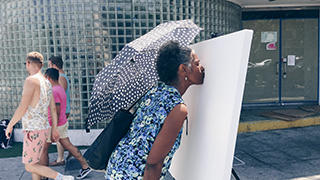
Series of White Painting
This seemingly blank white canvas series of paintings are impressed with the kisses of around 100 people each. Passersby in the streets of the U.S., Mexico, Taiwan and other international destinations were asked to kiss the canvas to create the work. On productive days, the project managed to capture kisses from about 50 people. The number of total participants has already exceeded 600.
Some Russian Orthodox chapels and churches have the religious icon in the center, which is surrounded by walls and dividers inside the building structure. My description of "Series of White Painting" being a minimal construction was realized when I noticed the art possessed elements of both canvas and people and created an amorphous structure that established a space for individuals on the canvas.
Numerous discussions have been made on the limitations of paintings, but my perspectives on them are slightly different from others. I always feel that we can always find more possibilities in the things we do. There is significant news related to nations and governments, religions and cults, races and tribes, institutions and organizations, and other global units. Even within these units, segregations and segmentation, such as Brexit, walls at the borders, and refugees seem to be getting aggravated. "White Painting" was a project to validate the possibilities of smaller community units that are distinctively different from these segregated and segmented units.
To the people of 100 and 1000 years into the future
"Phantosia" is another work about which I would like to talk. It is an installation to perform Noh in complete darkness, and it was exhibited at The National Art Center, Tokyo, in January 2019. Noh performers said they had known of different variations of Noh, but the Noh performance in complete darkness is the first attempt in the millennium-long history of Noh. I spent three years on research to materialize "Phantosia," and I was already intrigued by the concept during the process of research. One person described the exhibition as the most profound experience in his 60 years of life. The reactions of the audiences far exceeded what I anticipated to bring to them. One of the interesting facts about the artwork is the interaction it has on its own, apart from the artist, with individual audiences and their lives. This can still happen even in 100 or 1000 years from now.

Phantosia
Phantosia is an installation for the audience to watch Noh performance in complete darkness. Noh performed in complete darkness with no sound elicit the possibilities of infinite imagery because of the invisibility. It was exhibited for two days for invitation-based audiences on January 21 and January 22, 2019, at The National Art Center, Tokyo.
One can describe "Phantosia" as a film work since the invisibility had most likely triggered the audiences to envision some imagery in their heads. It was almost as if those images were a part of "Phantosia." The state of invisibility generated infinite imagery, and those images were closely connected to an individual's personal memories, experiences, or even vernacular memories. Despite the common assumption that this work was a physical artwork as it stimulated senses, it was a rather unique work as it elicited imaginations and developed into unique stories based on the individuals' histories and memories.
The common element of these two artworks is that they exist and are real, but neither of them is visible. We can say that about society as a whole, not just about the artworks. At least to us, our visions can hardly detect anything.
Getting back to the main topic, I began contemplating the relationship between the exhibits and information after working on the two artworks. They opened my eyes to pay more attention to the invisible information lurking around the exhibit and in the atmosphere. In terms of information and creations, this is more like an information theory. Just by looking at the canvases of "White Painting," no one can envision the people who participated and how they kissed. Similarly, no one with today's technology can accurately replicate in drawling how this exact spot in this room looked like 30 years ago. No one knows how this place looked even an hour ago. To grasp the state it was in, we would need certain information. When it comes to exhibitions, the information we need is the background and process of the artwork. However, it is unnatural for this type of information to be available in the exhibition space.

Technique to control the time for thinking
No matter how deliberately the artist expresses the work as an untouched work or edited work, the distinction between the two can be ambiguous. With documentary films, the direction of the producer dominates the work and hinders their ability to control how much to edit. Exhibitions come with editing. As soon as the exhibitions are scheduled, editing takes place. When hosts, not just exhibition hosts, want to provide information to the audience, they frivolously incorporate editing in the work they are presenting. That information can be massive captions or supplementary films and photos. But the hosts sometimes fail to realize that these are not the type of information that the artwork needs. This led me to think about ways to create independent information without compromising the ambiance of the artwork. That is when the work proposal for "Cartier, Crystallization of Time" knocked on my door.
I was personally impressed by the extraordinary influence of Cartie's objets d'art. As soon as the jewelry was set up, the atmosphere began to harmonize. Just by looking at the piece, it is impossible for the majority of the visitors to know if the jewelry was worn by, for example, Grace Kelly. However, a superfluously lengthy caption may meddle with the jewelry's elemental influence. Our abilities to process information have limits and can sometimes create irrelevant information. Exhibitions are techniques to control time. The success of the exhibitions depends on the integrity of the techniques to properly place information, predict the movements of the visitors, and create the time for them to think. In other words, the key to success is the distance between the artwork and its information.
What I aim to learn is not the techniques but the philosophy
I have been fortunate to have stepped into biotechnology, AI, urban design, mobility, agriculture and other fields, all of which are foreign fields to us unless we come in contact with them. What is written in books may not be the accurate representation of the thoughts of those in the fields. Being a part of these researches has started to feel like curiosity and my lifework. What I really aim to learn is not the techniques but the philosophy that creates the techniques. The most important part is figuring out how to apply what I learn from these fields into my work. A 50-year-old painting, drawn with the latest paints and paintbrushes of that time, is uninteresting to me on its own.
I am not talking about a big future
I think we are in the midst of the transitioning phase to the next generation. One day, when looking back on today, it will most likely manifest itself as the generation of many movements, not stagnation. The older generations managed to change their situations to some degree by introducing big manifestos or principles; however, the next generation of people turned out to be the one who had to suffer the repercussions. In today's turmoil, simply resetting the situations back to zero is not an option. Still, to fix the situations, we have to attend to or mend each of the convoluted societal flaws.
I am not condemning the situation we are in. It might be just the timing of all. Who knows; we might even fail at fixing the turmoil despite our efforts. If that is the case, the future generations, in as many as 50 or 100 years, will probably reassess the old philosophy and make different attempts at fixing the problems. In retrospect, most of the grand plans for the future had little to no effect, and hyped manifestos usually ended up being futile. Indifference and irony only resulted in stagnation. All we can do is remember the past that led us to where we are today and do what we can do, no matter how minute they are. In that sense, art can do exactly what we need to do, and I anticipate it will play a part in the philosophy.

Displayed with Cartier jewelry, this mix media by Hiroshi Sugimoto is a trident sword from the Kamakura era being forged by a sword smith of the modern times.
Exhibit (From the closest to the farthest)
Necklace (2018) by Cartier
White gold/ 22 baroque-cut emeralds from Afghanistan weighing199.02 carats in total/ Spinels/ Garnets/ Onyxes/ Turquoises/ Diamonds/ Personal collection
Earrings (2018) by Cartier
White gold/ 2 baroque-cut emeralds from Afghanistan weighing 10.87 carats in total/ Spinels/ Garnets/ Onyxes/ Turquoises/ Diamonds/ Personal collection
SF, which originally stood for Science Fiction, is beginning to be used as the acronym for Speculative Fiction. Depicting the tremendous future with an engaging story like an outer space war is indubitably entertaining, but they tend to contain dystopia sentiments. The images build by SF have had a significant impact on our lives, and that impact is quite iniquitous. It is the authors' prerogative to depict the future however they want; however if it is our future they are depicting, who would want that kind of future?
Through my work, I do not talk about the far future, and consequently, I am not keen on the images that the word "future" implies. If we are not at that moment, despite it being a very near future or almost at present, it is still considered "the future." The state of me talking to you right now is considered the future to me from 10 minutes ago. The weight of the word "future" can have the light meaning as how I look at the 10 minutes into the future as the future.
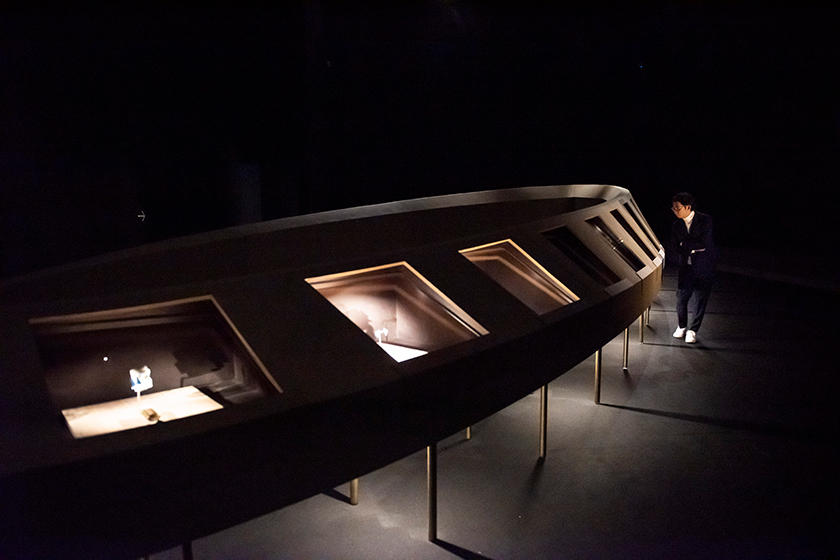
Eliminating the supernatural differences
I was born in the U.S., but I spent the majority of my life in Kobe. I moved to Tokyo about 10 years ago, and that was when I spent time observing Roppongi for the first time. The initial impression I got from Roppongi was similar to the time I visited Taipei. When I was walking through the area between Roppongi and Nogizaka, which is slightly dipped from its surroundings, I saw Roppongi Hills peeking in the haze between trees, behind the rows of old shops, followed by a small park tucked away in the back. The view in front of me was divided horizontally, not vertically, and looked like a scene out of the Final Fantasy VII. The difference of elevation in Roppongi is accentuated by aerial passages and other parallel passages above the ground passages. The same difference in elevation can be observed in Shinagawa and Tochomae. But the difference of elevation I am referring to here is not only limited to the difference created by the topography of mountains and valleys. They also include the difference that is created intentionally. The differences created instinctively from diverse cultures also exist here, and all these differences conceivably make up the city of Roppongi.
What I noticed recently, in a large-scale city like Roppongi, is tending to trees and curbs can change the look of the city even slightly. During my extended stay in Los Angeles, I noticed there was a large disparity in wealth. While one area of the city was equipped with sprinklers, had permanent lawns and vegetations, and was adequately paved, the adjacent area, which was considered a rough neighborhood, had lifeless trees and looked completely different. There is a stream in front of 21_21 DESIGN SIGHT, and I feel every big city should have an oasis in the heart of the city like in Roppongi. Gradually fixing the voids of the city is less imposing than demolishing something big and building something new. Besides, fixing the voids is probably more appealing to people.
As we, as well future generations, will progressively notice the awkwardness created by supernatural differences in the society, some of those differences will eventually be resolved. This is not because we go back to being socialists or the differences suddenly get resolved. Making small changes, again, will consequently erase the supernatural differences. When the formed disparity in wealth no longer exists, it will be intriguing to see how Roppongi will change and catch up with the societal changes based on all the problems that the city has. How will life have changed, and what will the overall happiness of people be? Will Roppongi be able to accommodate the changes? Maybe, the initiatives to mend the voids can give the city a brand new ambiance, and the steady efforts to fix discrepancies can reform the city into a very attractive one. Or it can be that we, or even the future generations, fail to find the use of the city, and the city becomes the city of entertainment or the city of hope.
Circulation of lives and artwork
Going back to the initial topic, I want to mention that the lives and artwork circulate. As the audiences have their lives, the artwork and its artists have their own lives as well. The reaction between the artwork and audience depends on the physical and mental conditions of the day, means of transportation used, cities they transited, people they talked to the night before, news they heard, an event which took place 6 months ago, and numerous other indexes. My objective in the artwork is not to change people's lives, but I know my artwork has an influence on them to a certain degree. It can influence someone today or someone in 100 years. The obscurity is what makes art intriguing.
Space Design: The New Material Research Laboratory
© N.M.R.L./ Hiroshi Sugimoto + Tomoyuki Sakakida
【Exhibition Summary】
Exhibition Title:Cartier, Crystallization of Time
Dates: Until Monday, December 16, 2019
Venue: The National Art Center, Tokyo
Editor's thoughts
This 30 year-young contemporary art artist with a remarkable career has a rather realistic point of view. He wants to collectedly look at the society from a bird's-eye view and identify the issues to leverage art to mend the societal flaws. Whether his realization was based on today's generation or his own uniqueness was not discussed today, but his conviction for art was evident in every word spoken. Experiencing the non-caption system at "Cartier, Crystallization of Time" will surely immerse the visitors in his passion for art.(text_ikuko hyodo)
Top picture: "Backward Clock" 2018 by Hiroshi Sugimoto/ Mixed media: A 1908's clock by Cesare Fontana of Milan was replicated to tick backward by Hiroshi Sugimoto/ Private collection
Space Design: The New Material Research Laboratory
© N.M.R.L./ Hiroshi Sugimoto + Tomoyuki Sakakida
RANKING
ALL
CATEGORY




